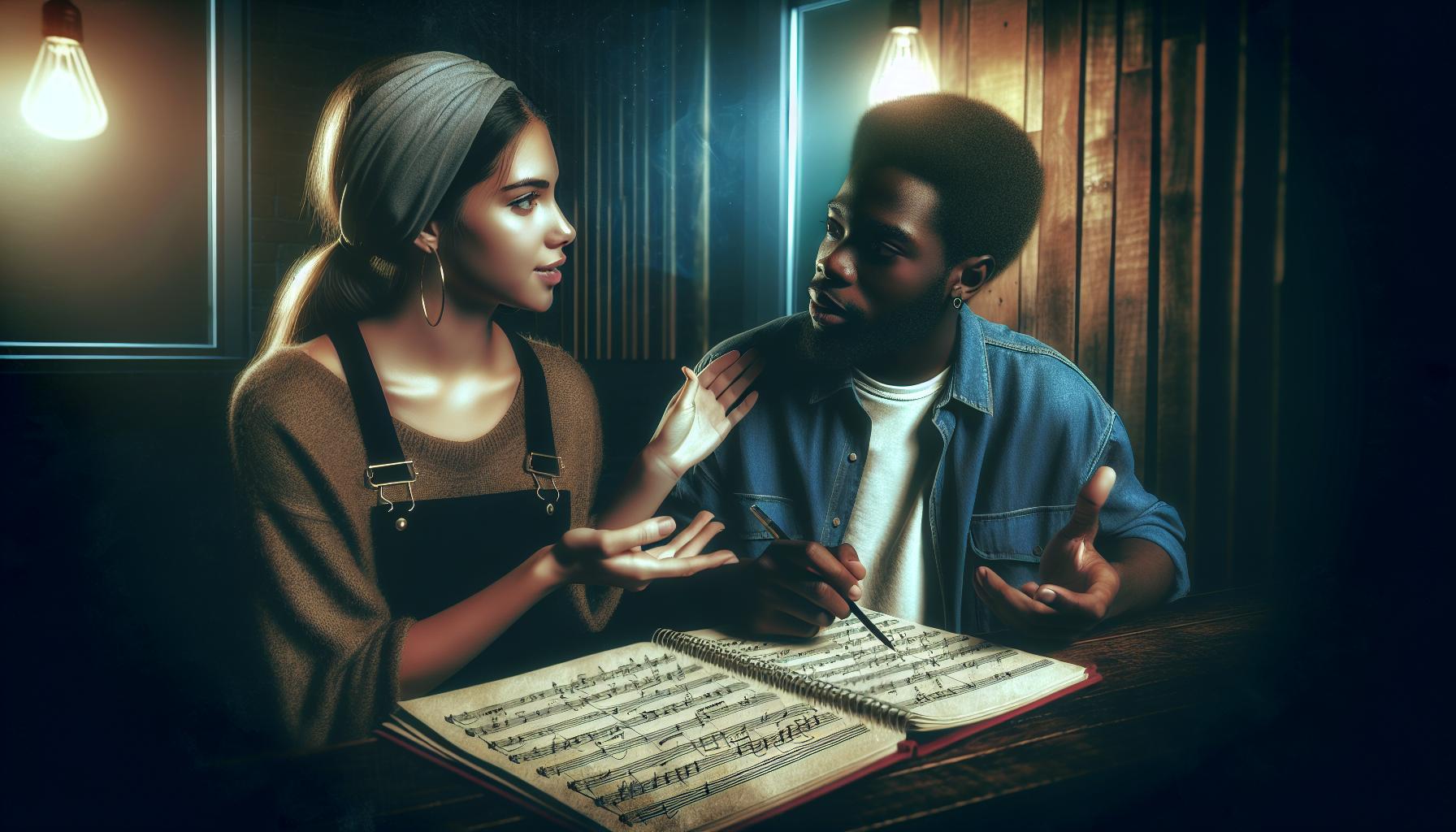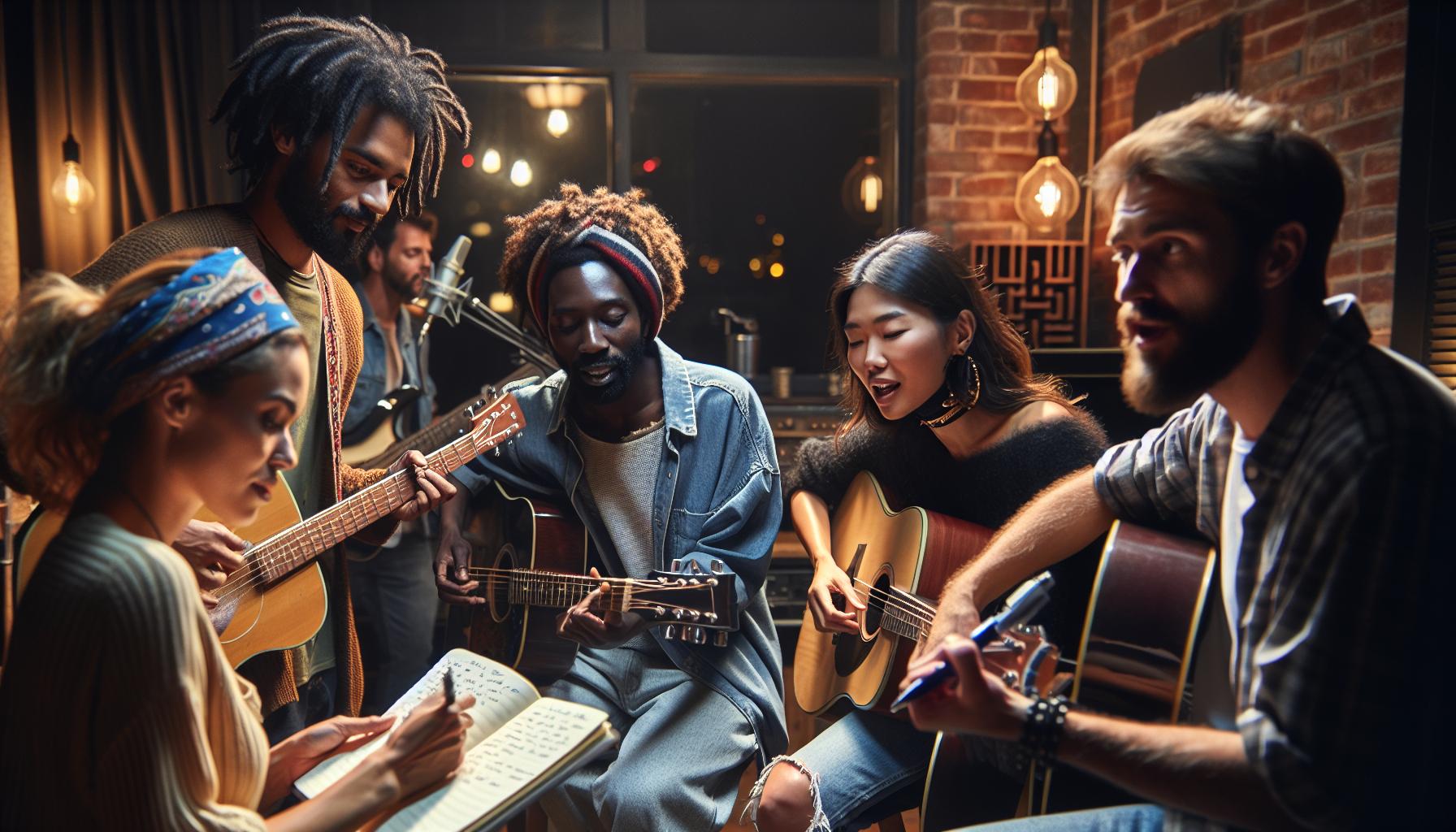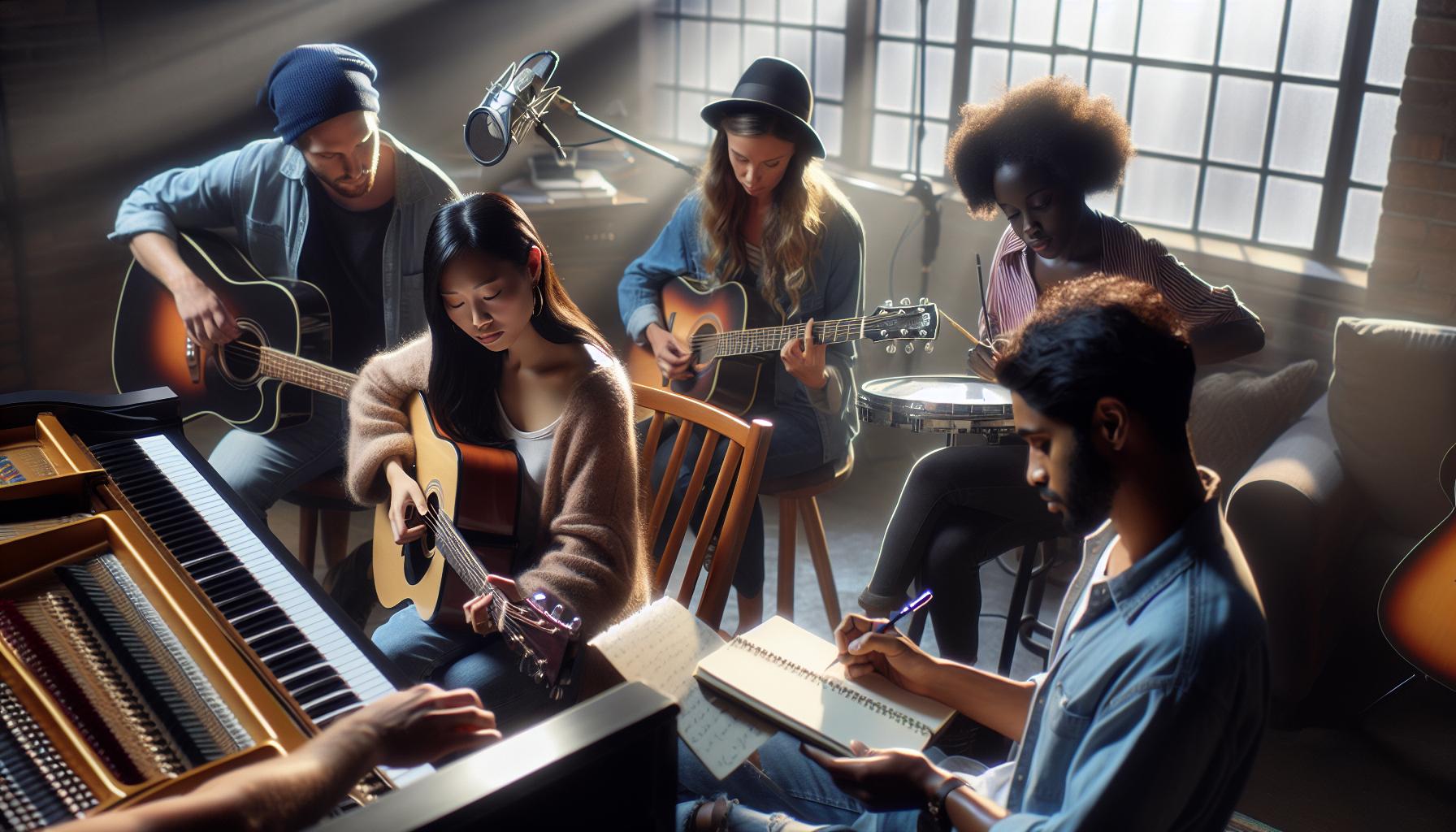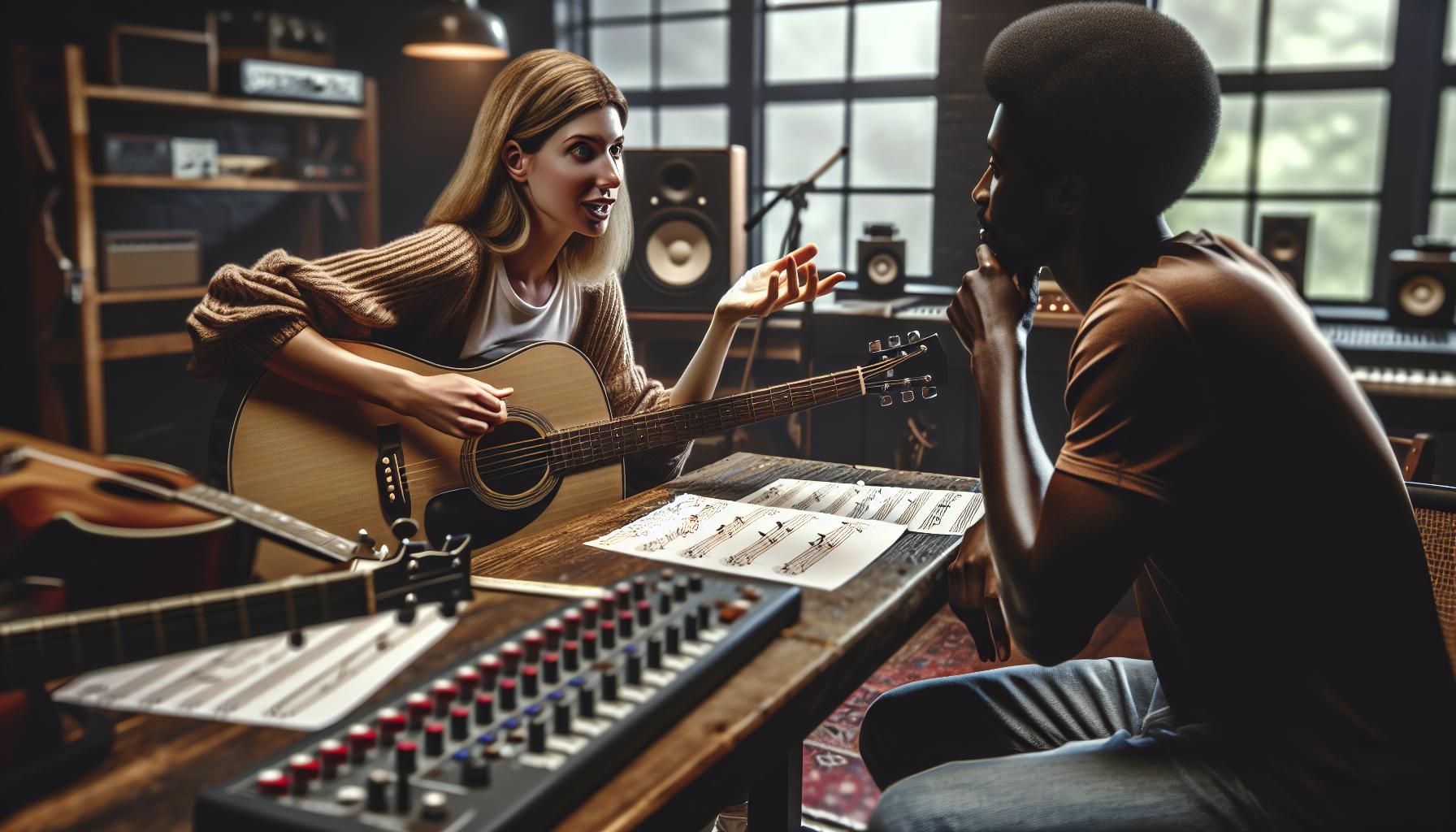As a seasoned songwriter, I’ve found that one of the most rewarding experiences in my career is collaborative songwriting. It’s not just about combining creative forces, but also about learning, growing, and pushing boundaries together.
Collaborating with other songwriters can be a game-changer. It’s a chance to step out of your comfort zone and explore new musical territories. It’s about merging different styles, ideas, and experiences to create something truly unique.
Contents
Finding the Right Collaborators
The process of finding the right collaborators can seem like a daunting task, but it doesn’t have to be. When starting your search, you want to find individuals who complement your skills and style but who also challenge you and push your creative boundaries. Here are some helpful tips to guide you in finding the right collaborators.
Networking is key. Attend local music events, songwriter meetups and industry conferences. These environments are the perfect places to meet those with similar interests and potentially compatible styles. Don’t forget online platforms, either. There are many websites and social media groups dedicated to music and songwriter collaborations.
It’s also essential to look for collaborators who share the same passion for music as you but have different skills and perspectives. This not only diversifies your music but also aids in learning and growing from each other. Always remember: A collaborator isn’t just someone who fits your style but also someone who can push you out of your comfort zone.
Another important element to consider when choosing your collaborator is compatibility. Yes, it’s essential that you musically vibe together, but the process will be a lot smoother if you also get along on a personal level. Make sure your personalities and work ethics align as this will help keep the collaboration enjoyable and productive.
Lastly, listen to your gut instinct. Sometimes, clicking with someone goes beyond skills and experience. If something feels right about a potential collaborator, give it a try. You might be surprised at the masterpieces you can create together.
While these are great points to help kick-start your search, there’s no one-size-fits-all method to finding the perfect collaborator. Always stay open to the process and remember that it’s about creating beautiful music, enjoying the journey, and growing as an artist.
Setting Clear Goals and Expectations

Once you’ve ignited the spark of collaboration, it’s essential to fan the flame with clarity. Setting clear goals and expectations are pivotal pillars of successful songwriting collaborations. Crafting a song is a process, with each step demanding foresight and direction.
Clearly defined goals give your collaboration an aim, a guiding light if you will. It’s not about setting rules, but creating a roadmap. The roadmap navigates the journey, ensuring everyone involved understands the destination. An aimless journey might offer unpredictability, but on a collaborative endeavor, it’s precarious.
Your goals could encompass various aspects of songwriting like genre, theme, or the intended audience. Understanding whether you’re writing a chart-topping pop anthem, a reflective folk ballad, or a hard-hitting rock number not only sets the tone but guides the creative process.
Transparent expectations, on the other hand, manage the dynamics of collaboration. It’s the bare bones of the collaboration “contract”. Being on the same page is crucial when you’re laboring side by side, creating something close to your hearts.
Work division, timelines, financial arrangements are just a few considerations that should be openly discussed. If I’m working with a lyricist, we need to agree on who takes ownership of phrases, verses, or entire songs as the creative process unfolds. If I’m the composer, defining financial terms transparently from the get-go eliminates any potential begrudgements.
In my experience, a chart-topping songwriter, I’ve found that explicit conversations about songwriting credits, royalties, and potential performance rights often prevent serious misunderstandings and preserve the harmony of the creative relationship.
Turning up with an open mind, collaborative humility, and a shared sense of creativity is important. However, having clear goals and setting expectations form the underpinning structure that allows the creativity to bloom. This step might feel like a hurdle, but it’s really a launchpad propelling musical brilliance and collaborative success.
Establishing an Open and Respectful Communication

Continuing on, let’s dive into the role of establishing an open and respectful communication. Communication is the backbone of any successful collaboration and collaborative songwriting is no different. In songwriting, creativity blossoms in an environment where there’s open dialogue and feedback cycles, creating a synergy between collaborators. But how can we ensure this happens in our collaborative efforts?
Firstly, establish a safe space for sharing ideas. Encourage everyone involved to open up, share their thoughts, and feedback. This encourages the sharing of diverse, creative ideas and sets the crucial foundation for your songwriting efforts. Remember, it’s not always about agreeing. It’s about understanding and respecting each other’s viewpoints to create something truly unique.
Secondly, inculcate active listening. I can’t emphasize enough how essential it is for everyone in the team to actively listen and understand each other’s contributions. This isn’t just about listening to the words. It’s about understanding the essence of what’s being conveyed, absorbing the feelings, emotions, and the subtext. When we truly understand each other’s perspectives, the collaboration becomes smooth and productive.
You also need to maintain transparency and trust. Be upfront about your capabilities, your expectations, strengths, and weaknesses. This will allow the team to leverage individual strengths and compensate for weaknesses, ultimately meeting the objectives set earlier.
Finally, remember that regular communication is key. Encourage frequent discussions, songwriting sessions, and revisions of the work. This keeps everyone on the same page and promotes an active engagement that boosts the collective creative output.
Balancing these communication aspects will help build an environment that’s conducive to creative brainstorming, promoting smooth collaboration. This nurturing environment will significantly enhance the quality and depth of your songs, while ensuring a fulfilling collaborative experience.
Sharing Ideas and Feedback

An important aspect of collaborative songwriting is sharing ideas and feedback in a respectful and supportive manner. Open and active communication is key. But remember, it’s easier said than done.
When I engage in a songwriting collaboration, a crucial step I’ve always emphasized is creating a safe space for everyone involved. This space promotes creative freedom, where every member feels equally important and valued. There’s no judgment here, only respect for everyone’s contribution.
A valuable habit is to actively listen to your peers during discussions. Active listening involves fully concentrating, understanding, responding, and then remembering what’s being said. This allows us to fully understand suggestions, ideas, and constructive criticisms. Remember, we’re all working towards the same objective—to make a great song.
It’s also vital to be transparent when offering feedback. Open and honest critiques might seem harsh initially, but they’re instrumental for growth. So, don’t be afraid to voice your thoughts.
| Skill | Importance |
|---|---|
| Active Listening | Promotes understanding and effective communication |
| Transparency | Encourages honesty and builds trust |
Instead of nitpicking, offer solutions and discuss improvements. Indicate your points through examples in order to avoid confusions. In situations where you’re on the receiving end, it’s crucial to keep an open mind and consider other perspectives. But first and foremost, have respect for your colleagues’ creativity and point of view.
This sort of reciprocal feedback creates a sense of mutual respect, understanding, and trust between collaborators. It fosters a creative dynamic and promotes a harmonious collaborative environment, ultimately leading to the creation of better quality songs.
Remember, the crux of collaboration is to maintain a balance between input and feedback. It’s about harmonizing different thoughts to form a beautiful song. So, let’s do it right.

Stepping into the world of collaborative songwriting often paves the way for creative differences in the team. But fret not! These differences are not hurdles but rather opportunities to construct an artistically diverse and profound piece of music. Let’s delve into tips and tricks to navigate these creative challenges.
While the first meeting with co-writers is about building rapport, I’d suggest focusing the second meet-up on writing musical pieces and embracing the individual creative differences. Believe me, every co-writer brings a unique palette of ideas, experiences, and styles to the blend. Be it their distinct lyrical approach, a characteristic chord progression, or an unusual melody line. These elements, stemming from differing creative instincts, can enhance the depth and originality of the entire musical piece.
The key to dealing with creative differences is an embracing and open attitude. That means, instead of trying to converge all ideas into one, appreciate the richness and diversity of multiple ideas. It’s about coalescing our flair and finesse to create a masterpiece.
Then there are times when differences escalate into disputes. When such situations arise, rather than letting personal pride and prejudice rule, remember – it’s about the song, not egos. A rule that can be applied at such junctures is the “song wins” rule which simply means – the best idea for the song triumphs. Here, it doesn’t matter who suggested the idea originally; if it suits the song, it stands.
Being in a creative space, critiquing ideas tactfully around the table is a must. In such moments, even if someone’s idea gets shot down, it should not discourage their contribution in future. Rather, it should be an instigator for better quality discussions, fostering a healthy competitive environment.
When we navigate these creative differences with respect and openness, it leads to a collaborative synergy where every twist and turn in the creative process contributes to a highly diverse and rich musical piece. And that’s when collaborative songwriting truly turns into a thrilling and fulfilling experience.
Balancing Workloads and Responsibilities

In the realm of collaborative songwriting, balancing workloads and responsibilities is a fundamental factor. It can impact the smooth functioning of the collaboration as well as the quality of the final product. Sharing the workload and clearly outlining individual responsibilities can eliminate the risk of confusion and misunderstandings.
First off, it’s essential to determine who does what when it comes down to songwriting tasks. Perhaps one person is better at coming up with melodies while another might excel at writing lyrics. Recognizing each member’s strengths and leveraging them can enhance the collaborative process. Allocating responsibilities based on strengths also ensures that every team member is in their comfort zone, which can amplify the overall level of creativity and productivity.
Moreover, clear communication of responsibilities can prevent conflict within the team. This step involves outlining the intended expectations for each role and ensuring that all team members understand and accept these expectations. It might also involve discussing what happens if someone cannot fulfil their responsibilities and developing a backup plan to prevent workflow disruption.
Another aspect to consider is workload balance. An unequal distribution of responsibilities can lead to feelings of resentment or burnout among team members. Encourage everyone to contribute based on their comfort and capabilities, but also ensure that no one feels overwhelmed or undervalued.
Let’s look at a few bullet points that can guide you during the process:
- Define individual responsibilities based on each member’s strengths.
- Communicate expectations clearly to prevent misunderstandings.
- Develop a backup plan in case someone can’t fulfil their tasks.
- Maintain workload balance to keep the team motivated and active.
By efficiently managing workloads and sharing responsibilities, you can lay down a strong foundation for successful collaboration in songwriting, enabling a productive and harmonious environment that helps churn out hits.
Incorporating Each Collaborator’s Strengths
As we dive deeper into the complexities of collaborative songwriting, a key aspect becomes apparent: leveraging each collaborator’s unique strengths. It’s not just about writing a song together, it’s also about making sure everyone’s skills shine in the process.
There’s no one-size-fits-all when it comes to songwriting partnerships. Everyone brings something different to the table. Johnny might have a knack for melodious hooks, while Jane could be the queen of versatile lyrics. In a collaborative environment, it’s essential to recognize these strengths and make sure they’re utilized effectively.
You might ask – how do we do that?
Firstly, it’s crucial to have open conversations about strengths. Before starting, spend some time discussing what each person excels at. This will not only provide clarity on who should handle what, but it also encourages a positive environment where everyone feels valued and appreciated for their unique talents.
Secondly, review each other’s previous work. This allows for a better understanding of everyone’s style, strengths, and possible areas of improvement. It’s a great way to get a sense of what each person brings to the table.
Lastly, consider fluidity of roles. While it might be tempting to box people into specific roles based on their strengths, remember that creativity isn’t always linear. Allowing for some flexibility can lead to unexpected bursts of innovation.
To illustrate the impact of incorporating everyone’s strengths, let’s compare two hypothetical songwriting sessions:
| Session A: No Strengths Consideration | Session B: Strengths Utilized | |
|---|---|---|
| Melody | Everyone contributes equally, resulting in an inconsistent melody | Melody master takes the lead, creating a harmonious and catchy tune |
| Lyrics | Lyrics seem disjointed as there’s no clear voice | Lyricist pens a powerful and emotional narrative |
With these steps in mind, the journey of collaborative songwriting becomes a playground for creative optimization. Each person’s unique abilities are encouraged to bloom, creating a beautifully balanced composition.
Building Trust and Dependability

Being a proponent of collaborative songwriting, I’ve learned that the core of any successful partnership lies in building trust and dependability among participants.
Trusting each other’s skills and abilities creates an environment conducive for creativity. It’s not about competing with each other; it’s all about playing to each other’s strengths.
Dependability, on the other hand, is about consistency and reliability. Can your collaborator sustain their commitment throughout the long songwriting process? Do they show up when they say they will?
Here are some practical steps you can take:
- Open communication: Make it a point to establish an open line of communication right from the start.
- Respect and valuing contributions: Don’t belittle your collaborators. Their ideas, no matter how unusual, could be the key to composing a hit track.
- Be dependable: Show up, not just physically but mentally too. Be ready and eager to contribute.
Remember, trust is earned, not given. They’re not just collaborators; they’re your team. Working as a unit, appreciating each other’s craft and maintaining a steady level of dependability is crucial for building a solid songwriting team.
Through the ups and downs of the songwriting process, this reinforced bond of trust and dependability will greatly contribute to the final outcome. You’ll harness everyone’s unique strengths, creating a harmonious and balanced composition.
Though individual strengths are key, keep in mind that collaboration is about the collective strength of the team. With trust and dependability at the foundation of your team, you’re setting yourself up for a successful songwriting partnership.
Handling Creative Conflicts

Encountering conflict during the creative process isn’t uncommon. In fact, creative conflict can even be healthy for your craft, pushing you to look at your work from various perspectives. However, it’s how we handle these conflicts that determine the fate of the collaboration.
When differences arise, it’s important to revisit your original goals and expectations. Let’s not forget why we’re here: to create a harmonious and balanced composition together. Reflect on the original vision for the song, and try to find the middle ground without compromising the essence of the music. Music, at its core, should express authenticity and human experience – don’t let a creative conflict dilute that.
To handle creative conflicts, I recommend a constructive and respectful dialogue. Encourage everyone to voice their opinions and ideas, then facilitate a conversation that uses these differences to enrich the final outcome, rather than detracting from it. We’re all on the same team, looking for the best for our creation. Disagreements shouldn’t be seen as personal attacks, but as opportunities to learn, grow, and improve the song.
Dependability goes hand in hand with trust when resolving conflicts. As collaborators, we need to not only trust each other’s abilities, but also depend on one another to follow through with tasks and responsibilities. If you’re someone who’s missed a deadline or failed to follow up on a task, it might be time to regain your partners’ trust. Remember, dependability is not about being perfect; it’s about being responsible and owning up to your mistakes.
Lastly, the key to handling creative conflicts is patience. Creativity does not follow a rigid timeline and forcing solutions can often lead to more tension. Give yourself and your team time and space, understanding that great ideas often come from a place of reflection.
When it comes to collaborative songwriting, there will be peaks and valleys. It’s through this creative journey, of course, that we become more adept at handling creative conflicts and strengthening our craft. We become better songwriters, better collaborators, and perhaps most importantly, we learn how to create a harmonious piece of music that stands the test of time.
Giving Credit and Sharing Royalties
Proceeding with our discussion on collaborative songwriting, giving credit where it’s due and sharing royalties properly is another essential aspect to address. Given the collaborative nature of the process, it’s pivotal to ensure every contributor gets their fair share of acknowledgment and monetary compensation.
During the initial stages of the collaboration, you should deem it vital to talk openly about the division of royalties. It might seem uncomfortable discussing financials with your fellow creators, but it’s necessary to avoid future conflicts. You can also engage the services of an entertainment attorney if circumstances necessitate.
When it comes to giving credit, consider all aspects of the creation process. Be it the lyric writing, melody creation, or the chord progression, all elements contribute to the final piece of work. Acknowledge the contributions of all collaborators and remember, fair credit not only boosts morale but also fosters an atmosphere of respect.
To ensure equitable distribution of royalties, you should establish an agreement on the royalty split from the outset. Traditionally, songwriting royalties are divided equally among all contributors. But, the division may vary based on individual contributions. For instance, if one person wrote the majority of the song, they may receive a larger percentage. It all revolves around open discussion and mutual agreement.
Use tools and services like ASCAP (American Society of Composers, Authors and Publishers) and BMI (Broadcast Music, Inc.) to facilitate royalty distributions. These entities help manage royalty splits and guarantee that each collaborator gets their deserved share.
In the end, regardless of the nature or level of contribution, every collaborator should feel esteemed for the role they played in creating the song. This recognition not only validates their efforts but also creates a healthy creative environment for future endeavors. Remember, when most people hear a great song, they may not know the hours of debate, sharing, and transformation that went into it. It’s your job to keep those workings fair and transparent, where every effort is recognized and rewarded.
Conclusion
Collaborative songwriting can be a rewarding journey. It’s all about finding the right partners, setting clear goals, and maintaining open communication. It’s crucial to respect creative differences and navigate them effectively. Remember, every collaborator’s contribution is significant in the song creation process. Don’t shy away from discussing royalties and giving credit where it’s due. Tools like ASCAP and BMI can be extremely helpful in managing royalty distributions. So, embrace the spirit of collaboration, acknowledge each effort, and let the magic of collective creativity unfold in your music. After all, a well-crafted song is a testament to successful collaboration.
